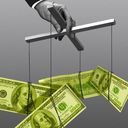How the Fed took control of the economy

To brace the U.S. economy and stave off another Great Depression, the Federal Reserve has taken control of it through unprecedented intervention — manipulating market prices, controlling rates and propping up companies on a previously unimaginable scale.
Why it matters: The U.S. is a market-run, capitalist economy. But the market is ostensibly now governed by an unelected and largely independent group of technocrats that directs it by creating ridiculous sums of money to buy assets.
- Even with this control, the Fed has by its own admission failed to fully reach its goals — stable prices and maximum employment.
How it works: The Fed steadied the economy by setting interest rates near 0%, and buying so many bonds in the open market that it now boasts a $7.7 trillion balance sheet.
- The hope is that companies will hire more workers, but that's no longer how the economy works, notes Columbia University professor and Nobel Prize-winning economist Joseph Stiglitz.
- Rather than hiring, companies buy back their stock and invest in technology designed to replace workers.
"We’ve been through a period where low-interest rates have not stimulated the economy very much and where disproportionately [companies' increased profits] go into automation, killing jobs, not creating jobs," Stiglitz tells Axios.
- "At a zero interest rate the cost you focus on is the cost of labor, because that’s your only cost. Whereas if the cost of capital goes up relative to the cost of labor you get a more balanced kind of innovation and investment."
Yes, but: Many argue the Fed was forced into this position and the extraordinary economic intervention is its attempt to make up for a new world of slowing growth, growing debt, an aging population and a dysfunctional Congress.
What happened: To battle the coronavirus pandemic, the Fed announced on March 23, 2020, that it would buy an unlimited amount of U.S. government bonds and mortgage-backed securities; purchase corporate bonds, including debt with a "junk" credit rating; and even provide financing directly to individual companies.
Take it to the street: "Why does the Fed have outsized influence on financial prices? Because it’s shown itself willing to act," Vincent Reinhart, who spent 20 years as an economist at the Fed, tells Axios. "If something really bad happens, [Fed chair Jerome] Powell is stepping in."
- "The lunchtime bully doesn’t enforce order on the school playground by beating everybody up, they just have to beat one or two kids up," Reinhart, now chief economist at Mellon, adds.
The intrigue: Knowing that asset prices can fall only so far before the Fed will act encourages market participants to buy at any level.
- It also has essentially destroyed the ability of the market to determine companies' value, Scott Minerd, CIO of Guggenheim Partners and an adviser to the New York Fed, told me in the midst of the crisis.
- "The definition of market prices is whatever the Fed says it will be."
The results
The combination of low-interest rates and inflated asset prices discourages saving and encourages risk-taking, empowering a wave of speculative investments.
- The effects can be seen in the rise of Bitcoin (hailed as a savings asset that the Fed can't manipulate), the frenzy in "meme stocks" like GameStop, and the rise of the stock market to record highs even as the economy had its largest contraction since 1946.
- The Fed's policies also allowed big companies to issue record amounts of debt at record low levels, keeping many of them in business and able to run essential functions.
- But that privilege also has extended to unprofitable "zombie" companies — those without enough revenue to pay off their current monthly debt obligations — and kept new and vibrant firms from disrupting inefficient ones.
Where it stands: The benefits of this extreme action are supposed to reach everyday Americans but are largely resulting in a bonanza for the wealthy (just under 90% of stocks are held by the top 10% of U.S. households and homeownership rates skew significantly toward older, wealthier white Americans) and large corporations.
- More than a year after the Fed launched its market onslaught there are still 8.4 million fewer Americans employed than before the pandemic, food insecurity has increased and poverty rates remain elevated.
- America's billionaires, on the other hand, have seen their fortunes grow by nearly $1.5 trillion.